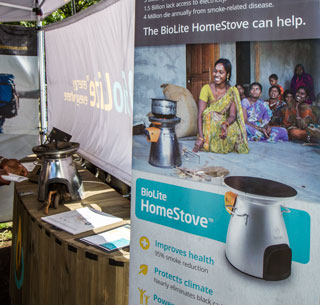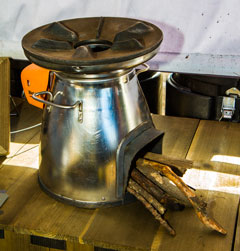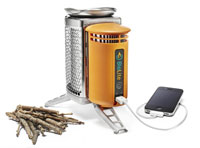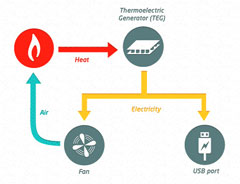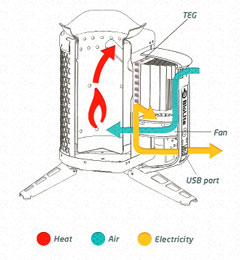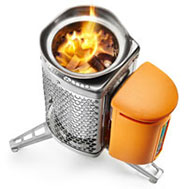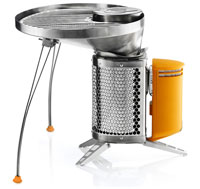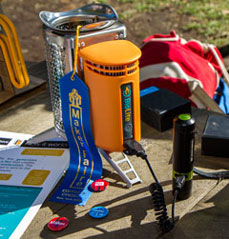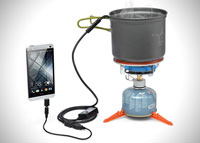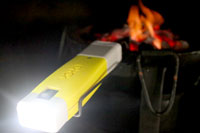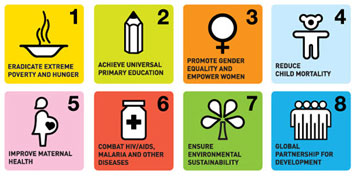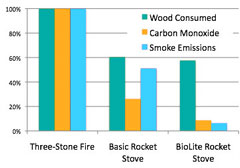|
|
|||||||||||||||
Social Entrepreneurship and the Thermoelectric Effect Imagine for a moment that you are one of the three billion people on our planet who lack the most basic of resources and must cook your food over a crude open wood fire. If you're thinking,"Hey, not so bad, it's like camping," let me disabuse you of that romantic notion. The impoverished of this world make sooty cook fires, often inside their ramshackle dwellings, and the resulting indoor air pollution causes massive health problems. Four million people die each year from the effects of prolonged exposure to smoke. Now imagine that you're even more unlucky and you're among the one and a half billion people worldwide who lack access to electricity. Even though you might own a basic cell phone (many of the very poor in sub-Saharan Africa and India do), keeping it charged is a big challenge. There are now over five billion cellphones in use, and they are the primary mode of communication in the largely unwired poor regions of the world. If you think you're dependent on your phone, imagine how essential it is when you have absolutely no other technology in your life. And because there are no outlets anywhere close, you need to walk several miles into town three times a week to visit a shared charging station. OK, so we have almost a third of the population making crude "three stone" wood fires every day, depleting natural resources and creating over a billion tons of CO2 annually. (Many also burn toxic kerosene in lamps, which further exacerbates the indoor air pollution problem). A billion and a half people have no electricity for charging their lifeline phones or for lights. Lack of indoor and nighttime lighting is a contributing factor to educational deficits and other social problems.
Yes, it's depressing, but good people are working on solutions. I'm going to highlight one of them now, and focus on a company called BioLite. I came across BioLite when I attended New York's fourth World Maker Faire last weekend. (Next month I'll have a full write-up on other cool stuff I discovered at the Faire, but I was so intrigued by BioLite, I wanted to bring their story to you first). Through my two sons Jourdan and Alec, I've become very aware of the social entrepreneurship movement that's taking root among the younger generation. My boys are both social entrepreneurs, meaning that they are involved in for-profit ventures that attempt to solve social problems. The co-founders of BioLite are also social entrepreneurs. Alec Drummond and Jonathan Cedar were employed at a NYC design firm when they became aware of the third-world wood fire problems I touched on above. They had the idea to combine a hyper-efficient wood burning stove with a thermoelectric generator, and make it available for purchase in poor countries at a greatly subsidized cost.
The same technology that underpins BioLite's "HomeStove" deployed in third-world nations is perfectly suited to domestic use as a camping and survival "CampStove." Sales of $130 CampStoves subsidize the firm's deployment of HomeStoves in developing nations (that's their social entrepreneurial business model, although there are numerous other viable economic models that achieve the goal of profit-making societal good). Now, on to the technology and its application. You may be familiar with solid state refrigerators and cooling devices. These use a "thermoelectric module" which converts electricity into a temperature differential. I actually have a thermoelectric cooler for my cat's water bowl (I know this sounds like a silly first-world issue but it's been discovered that cats drink more water if it's chilled, and this is very important for cat health. Perhaps another article subject?). These no-moving-parts devices employ the Peltier effect and its converse, the Seebeck effect. Therefore, they can also run in reverse: that is, establish a temperature difference (between a flame and the ambient air for example), as input and get electricity as output. Done properly, this creates a substantial source of power, sufficient to run a fan as well as charge cell phones, LED lights, and other portable electronic devices. The fan is important. An internal electric fan blows air through the stove to dramatically increase combustion efficiency. The result is a virtually smokeless fire with minimal carbon monoxide production.
At the Maker Faire I came across BioLite's display at the end of a long day at Maker Faire but was instantantly drawn in by their appealing presentation and the enthusiasm of the staffers demonstrating the stoves and accessories.
Alternatives The BioLite HomeStove and CampStove are highly innovative products but there are others in this space. Here are two alternative devices:
Social Impact While camping and emergency use applications are very compelling, the real life-changing story revolves around applying thermoelectric and clean-burn technolgies globally. BioLite is currently test marketing the HomeStove in India, Ghana, Uganda, and Guatemala to determine cost structure and distribution requirements before rolling it out to other countries in Asia and Africa. The target price point is $40.
Enhanced cooking stoves address at least five of the eight Millennium Development Goals (MDGs) set forth by the United Nations: ending poverty and hunger, gender equity, child health, maternal health, and environmental sustainability. The burdens of fire-making fall disproportionally on women and children in the developing world. They spend hours gathering materials to burn (wood, dung, or agricultural waste) and tending the smoky "three stone" fires. Even when made outside, inefficient fires create plumes of smoke and soot that's inhaled and leads to multiple health problems. It's been estimated that the effect is similar to smoking two packs of cigarettes a day.
BioLite's History and Funding The company was founded in 2009 and is headquartered in Brooklyn, where over 20 people are employed. In April of 2011, BioLite closed on a $1.8 million Series A funding round led by Clay Christenson's Disruptive Innovation Fund, and have secured additional funds from angel investors. The firm is now cash flow positive. Founders Drummond and Cedar have roots in the Maker community. Early prototypes were built in a TechShop in Menlo Park (Near U.C. Berkeley which is apparently a "hotbed" of stove innovation). Suva Design assisted BioLite with their branding, packaging, and graphic design, and developed the firm's superb website. I think studying BioLite's site is highly worthwhile, just to see how good a website can be: it's clear, easy to navigate, well organized, and beautiful. I'll have more interesting stuff from Maker Faire for you next month.
|

